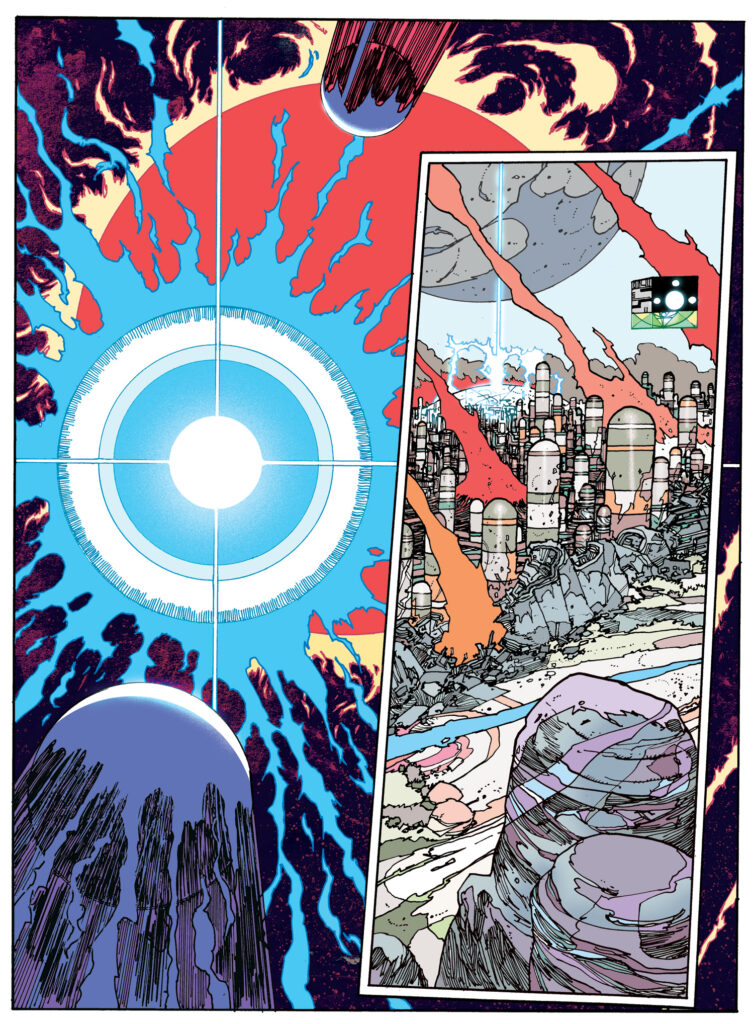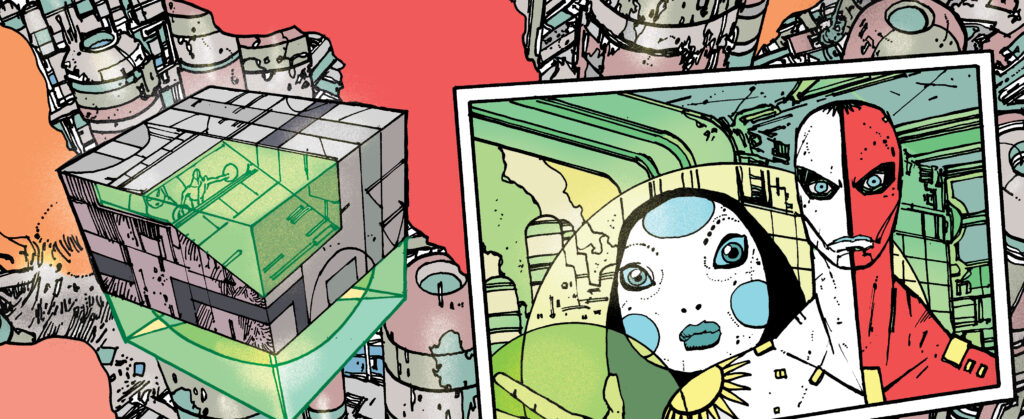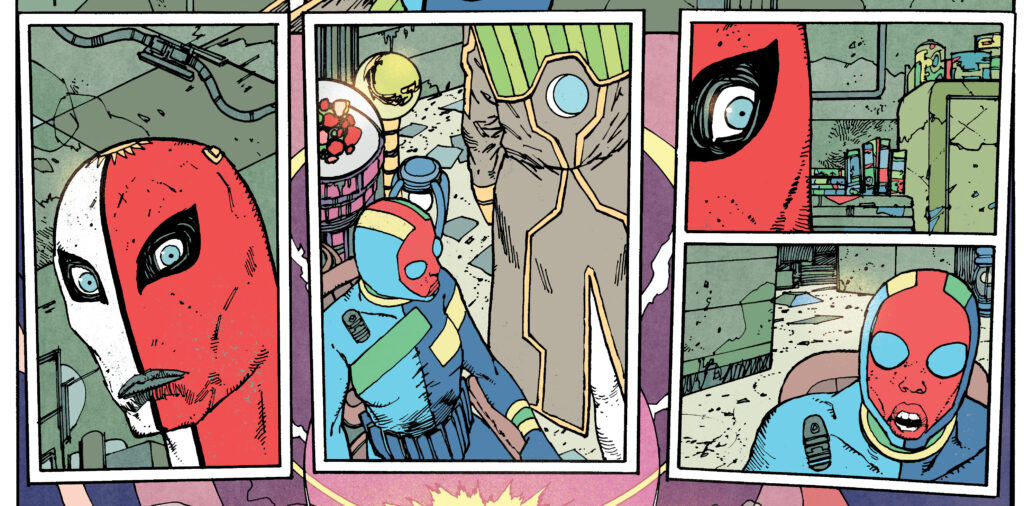INTERVIEW: who, or what, is Proteus Vex?
13th December 2019
This year, Santa is bringing you a little something extra in your Christmas stocking… the zarjaz 2000 AD end-of-year Christmas bumper issue – 2000 AD Prog 2162 – as the perfect cure for turkey-induced food coma!
Amongst the new Thrills powering their way to you in this very special Prog is a brand new series from Michael Carroll and Henry Flint, getting together for the first time since working on the Judge Dredd strip, ‘Dust to Dust’, in the Judge Dredd Megazine.
To discover more, Richard Bruton chatted to Michael and Henry to discover what to expect from this Thrill of the Future… Proteus Vex.

So, Proteus Vex… first and most obvious question is what’s it all about, what sort of big sci-fi themes can we expect?
MC: It’s a space adventure story! Weird aliens, giant spaceships, espionage, intrigue, action and so on. I’ve always been a huge fan of the old pulp SF stories by the likes of Edgar Rice Burroughs, Leigh Brackett, Sax Rohmer, Alex Raymond, Philip José Farmer, C.L. Moore, Robert E. Howard, Robert Silverberg, E.E. “Doc” Smith, Henry Kuttner, Ray Bradbury, Lester Dent, Fred Saberhagen and of course Harry Harrison.
Proteus Vex is my take on that kind of story. Science fiction, but where the science part is subservient to the fiction part. Much as I love Hard SF stories, sometimes it’s refreshing to set aside the hyperspace time-dilation calculations and fuel-to-mass ratios and intricately-designed complex biospheres, and just have a bunch of spaceships made out of “undefeatium” blasting the crap out of each other. We don’t always need to know exactly-how-the plasma guns work, just what they’ll do to the bad guy’s face.
Let’s drill down a little more into Proteus Vex now. Can you give you us more details on exactly what we can expect from this fabulous space adventure?
MC: The first Proteus Vex story is subtitled ‘Another Dawn’. It runs for ten episodes in the Prog, so that’s fifty pages and it’ll be starting in the Christmas Prog this year.
The setting is some four decades after the end of a very brutal fourteen-century-long intergalactic war against a race called The Obdurate. Everyone is still kind of picking up the pieces. The eponymous Proteus Vex was a soldier for the Imperium Ascendant, the winning side, and is now a trouble-shooting agent for the Ascendant. He’s not a very nice person. He’s less ‘James Bond in a tuxedo making smug quips’, more ‘stand on your neck until you tell him what he wants to know’. In this story, Vex has been assigned to track down a missing high-level officer of the Ascendant. This brings him to the pretty horrible war-ravaged world of Korregag, which is where the story kicks off.

Mike, when it came to developing Proteus Vex, is this something you and Henry were already working together or did the All-Mighty Tharg do a little match-making?
MC: I’ve been writing Dredd (and Dredd-related) strips for years, and I’ve pitched other ideas several times, but none of them resonated with Matt. So Proteus Vex will actually be my first wholly-original strip in 2000AD since my second Future Shock back in July 2009 (just over ten years ago as I write this!).
On a visit to the Nerve Centre last year I again mentioned that I was keen to branch out from Dredd, and Matt said that Henry would be coming free relatively soon so maybe I could write something with him in mind. I’ve been a fan of Henry’s work from the start – he is easily one of the most interesting and imaginative and accomplished artists working in comics today – and we’d already collaborated on ‘Judge Dredd: Dust to Dust’ for the Megazine, so that was pretty exciting. Matt suggested that something like ‘Jason Bourne in Space’ might work, and that sparked a few ideas.
I definitely wanted lots of strange aliens, which I knew Henry could do – his work on Shakara is absolutely stunning – but with a very grounded, down-to-scorched-earth protagonist. I’ve long had this urge to write about a post-war galaxy: I like the idea of a character looking up at a split-in-two moon! I really wanted to play with scale a lot, too: it annoys me with science fiction movies and TV shows where all the aliens are roughly human-sized, and that’s what inspired the Scorcher aliens that show up at the end of episode two.
It took me the usual few false starts to filter through my ideas and coalesce the good ones into a solid story, but everything came together when I came up with the character of Midnight Indicating Shame. She’s very naïve to Vex’s way of doing things, so her curiosity was a doorway through which I could introduce some of the stranger concepts.
And when you’re imagining a new strip like Proteus Vex, how much thought do you give to writing for a particular artist’s style?
MC: Proteus Vex is rare for me in that I’ve known right from the start that Henry would be involved, but here’s a secret: I generally write strips with an artist in mind even if I don’t know who it’s going to be! With a Dredd strip, sometimes as I’m writing I’ll picture it as drawn by an artist who’s no longer working on the comic: Ron Smith, Cam Kennedy, Garry Leach, Ian Gibson, Alan Davis, Dave Gibbons, Steve Dillon. It depends on the atmosphere I’m trying to evoke and the mood I’m in!
With Vex, I’m very familiar with Henry’s skill-set so I can easily picture how it’s going to look. And of course I will be completely wrong because Henry has a much stronger visual imagination than I have.
I’ll soon be starting work on the script for the second series, so I’ve asked Henry if he has any specific things he wants to draw – I’ll be more than happy to construct the plot around key scenes! (Which is how I do it anyway.)

Henry, how’s the collaboration going for you as far as the extensive design work involved with creating something new such as this is concerned?
HF: Well, I’ve always admired and have a lot of respect for Mike’s work. He’s prolific with a list of titles as long as your arm so a chance to get to work with him is very much appreciated, thank you Tharg. Sometimes I collaborate with writers but with this story the script has arrived fully formed. But I love creating new strips, I think it’s what I enjoy most.
Mike has given me some designs for the hardware but I’m a control freak and no offence to Mike as they were perfectly good designs but I had to go my own way otherwise I’d feel lost inside my own world, if that makes any sense. Apparently he’s fine with it but that’s because he’s a lovely bloke. The genesis of the script is all Mikes.
Designing Proteus Vex I wanted a face that had expression. Shakara had no mouth and the same eyes in every panel and after a while it became limiting so I wanted a face that could tell the reader what he’s thinking. Also I wanted a little super hero element to him and covered him in symbols as if he’s from some kind of secret order.
For the look for Proteus Vex, have you taken advantage of the opportunity afforded with the freedom of a new strip for firing off in a new artistic direction?
HF: For me a new strip means a new art direction. I felt the script sounded to me like a Moebius romp so having fun going off in that direction. Although it has to be said the more I look at his art the less confident I feel about my own so I have to be careful not to look at it too much. It’s important not to copy but it is possible to get a feeling and then you add your own. There’s also a bit of Shaky Kane in there too with his paint bucket style. Eye popping stuff. Credit where credits due. He’s a legend.
In terms of the difference with original material and working on established properties at 2000 AD, do either of you have any preference or is it more a case of a refreshing difference in terms of work and pushing yourself creatively in different directions?
MC: Although this is my first wholly original series for 2000AD, I’ve created a lot of other properties so I’m familiar with both methods. When you’re with an established IP you’re restricted in some ways, but boundaries are good: they give you something to climb over, and force you to be more creative. If you have complete freedom, sometimes you can’t get anywhere at all because there are so many options. (That’s a handy tip for upcoming writers… if you find yourself staring at a blank screen and don’t know where to begin, give yourself some limitations: an otherwise pedestrian story about an assassin becomes much more interesting if the assassination absolutely-has-to take place in a very public area.)

Both of you could be described as 2000 AD veterans by now, having worked for Tharg for quite a long time. Is it still something that gives you a thrill, seeing your name in the Prog or Meg?
HF: Being a long time reader myself I never get tired of seeing my name in the Prog. It a privilege to be part of the 2000 AD family.
MC: Yep! I still consider myself to be a fan first and foremost, so every now and then I have to remind myself that I have actually achieved my dream job. I tell you, eleven-year-old me is very proud of me!
And now you have that veteran status, what is the one strip or character from the long history of 2000 AD that you’d love to get a crack at?
HF: Well, Sláine and Strontium Dog are the two really big guns that I’ve not worked on but there’s not much I can add to those as they’re both perfection.
MC: I want to write all of them, naturally, but there’s one that I know will probably never happen, sadly… Dan Dare!
